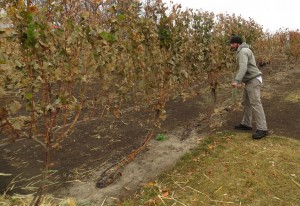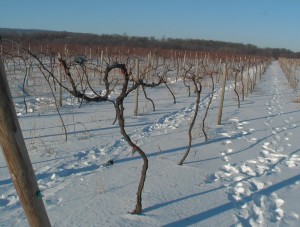Overuse of Multiple Trunks
When I began growing grapes in the 1970s at an experimental vineyard near my father’s orchard, it was routine to train vines to more than one trunk, a practice known today as ‘multiple trunks.” All the early growers used it and eastern academia generally embraced this technique as an integral element in cold climate grape culture.
In truth, it was a pain to employ, as training two trunks from the embryonic energy available from the new root was unsure. Often, one trunk grew more quickly than the other and one developed laterals and canopy more completely. Sorting this out as the new vines developed took time and skill and required continuous decision-making. Multiple trunks translated into additional time, effort and expense, that we initially felt was justified by established viticultural experience.
Our first hesitation with multiple trunks occurred during ‘test winters” wherein cold injury was notable. Following harsh winters, we did not see that one trunk was, in fact, in better shape than the other. Sometimes we found ourselves looking at an entire acre of multiple trunks, all uniformly dead. This was disheartening and we began to question if the extra effort devoted to developing multiple trunks had been worth it.
I began to research the origins of the technique and what it was meant to accomplish. My research found that multiple trunks were used in the early 1970s by Cornell University with Seyval grapes growing in New York State. Seyval was making excellent wine, but winter damage was reducing Seyval’s economic value in the region.
However, it was observed that vines which for one reason or another had two trunks, or had a trunk being trained as a replacement, the younger trunk often survived in better condition than the older one and often allowed partial cropping, even in the year of injury.
To continue reading this post, you must either subscribe or login.[login_form][show_to accesslevel=”annual-membership” ]
Moreover, this partial trunk could replace the injury more quickly than if a single trunk had been killed to the ground. A study was conducted and it was determined that for vines (like Seyval) that were being grown in a cold climate where they would sometimes suffer injury, production could be better maintained using multiple trunks. It seemed like this procedure had a place in northern viticulture and surely it does.
Unfortunately, in practice, the technique has been extrapolated to all varieties in all localities east of the Rocky Mountains. Sometime ago, I visited a vineyard south of Des Moines, Iowa. There I saw a block of Frontenac vines being grown on multiple trunks. Since Frontenac is reliably cold hardy in Minnesota, even north of the Twin Cities, the justification for using multiple trunks on Frontenac in Southern Iowa escapes me. The Iowa growers reported that multiple trunks were the ‘recommended procedure” but gave no specific reasons for doing so. This situation is clearly outside the parameters originally set for training multiple trunks.
I am not alone in this belief. Richard L. Thomas, Director of Viticulture, SRJC and columnist for Vineyard and Winery Magazine writes that his favorite question is, ‘Why do you train your vines with double trunks?” The most common responses he receives are: ‘I don’t know, but everyone else does” or ‘…to ensure against losing the vines from winter kill.” (1) In reality, the technique does not really effect vine survival at all.
It is important to note the following disadvantages of using the multiple trunks:
1. Any given vine generates a limited amount of energy. This energy is guided through the trunk to the canopy and ripening crop. If we create two trunks and, in some cases three or even more, we divide this energy in two or three, etc. Thus the crop gets only half or a third of the energy, nutrient and water coming from the root. It seems logical, even apparent, that the crop is being short-changed in this scenario.
2. Fully as serious is the fact that one trunk will almost invariably be stronger and more vigorous than the other. Thus the fruit on one trunk will ripen more quickly or have better sun exposure or more nutrients available to it. This can only increase variability in ripeness within the crop and increase quality problems at harvest.
3. Pruning is more time-consuming and complex when using multiple trunks. Deciding what crop load to leave with old trunks, what to leave with younger ones and what to leave with brand new trunks, that often should not carry any crop load, can also become a complex mental process.
4. Additional trunks need to be trained on a continuing basis. To be effective, the second trunk needs to be younger than the original. As years pass and the second trunk reaches maturity, a sucker coming from the root needs to be selected and trained so the original trunk can be removed once this third trunk becomes mature. This continuous selecting, training and removing of trunks is a notable additional expense and again increases crop variability.
However, we do not contend that here is no place for multiple trunks in eastern viticulture.
For example, when planting Seyval in Northern Iowa, experience tells us this vine will suffer injury fairly regularly. In such a case, multiple trunks, if properly employed, may be of value to better maintain production. However, if the same grower is planting Foch in this locality, it would rarely suffer injury there. As a result multiple trunks would offer little except additional cultural expense. There are numerous similar examples. Thus, in our view, before adopting or rejecting this cultural technique a grower needs to consider his site, the relative hardiness and past experience with the variety being grown.
Circumstances Justifying Multiple Trunks
1. Is the variety you grow highly valued but subject to intermittent cold injury in your locality? If so, multiple trunks may help maintain production after severe cold.
2. Is your vineyard is troubled by crown gall? Additional trunks are valuable in maintaining useful life and production as replacements, when older trunks become badly infected.
3. If you want to grow grapes that regularly suffer cold injury at your site, such as some pure Vitis vinifera grapes, burying vines is a possibility. Although covering of vines for winter protection is a dying practice in the north, allowing cold tender vines to develop additional trunks tends to keep individual trunks smaller and more flexible, thus easier to bury.
Training Trunks Of Varying Ages
There is an important additional point to make. The original work stressed the need to develop trunks of differing age. This is not something I was told to do when developing my first vines and is not emphasized in recent practices or at least growers are not getting this message. Two or three trunks, all of virtually the same age, as is seen in many vineyards, will react to cold temperatures and freeze/thaw scenarios the same. The original work stressed that one old trunk complemented by a substantially younger trunk, will respond to conditions differently. According to this doctrine, younger trunks theoretically stand a better chance of surviving than older ones.
However, as years pass both trunks will become old. Thus, training of young trunks to replace the oldest ones is critical in the successful implementation of multiple trunks and is at the very heart of the theory. Justifying multiple trunks is a continuous cultural process which needs to be continued for the life of the vineyard.

University of Minnesota vineyard manager John Thull uses multiple “J trunks” for vinifera vines that will be covered for winter.
Growers and their advisors need to consider that the Multiple Trunk Technique has the following limitations:
1. It has added cultural costs that need to be justified before it is used.
2. It incorporates quality disadvantages that need to be considered.
3. It helps maintain production after cold injury and does not affect vine survival at all. This is widely misunderstood among growers.
As a result, it is our belief that multiple trunks used for all varieties at all sites east of the Rocky Mountains, as is widely seen these days, is an over use of this valuable cultural technique and needs to be reconsidered. It should not be a blanket recommendation. Vines that will rarely or never suffer injury at your site cannot justify the extra pruning and cultural expense and the increase in crop variability implicit in this technique. Thus it appears clear that the use of multiple trunks is a technique that is grossly over-used in the Eastern U.S.
BIBLIOGRAPHY:
1. Richard L. Thomas, Vine Wise, Aug., 2001, Vineyard Views.
2. Ibid.
[wp_geo_map]
[/show_to][password-recovery-link text=’Lost Password? Click here for password recovery.’]




